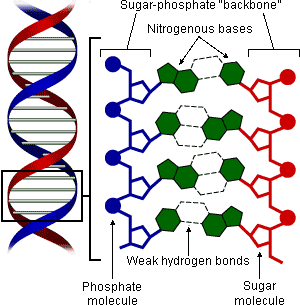DNA may be the most famous molecule in the world today, but it came to the attention of scientists rather late in the history of biology. Gregor Mendel found some of the underlying regularities of heredity almost a century before DNA was discovered. At the turn of the century scientists discovered similar principles then rediscovered Mendel’s work and rapidly realized that life was somehow encoded in genes. Just what those genes were made of was a mystery, but that did not prevent scientists from starting to work out the dynamics of genes and mutations, and how new forms of life could result from natural selection. The Modern Synthesis of evolution, the foundation on which most research on evolution has rested for the past 50 years, was already set in place years before DNA was discovered.
The structure of DNA

But there’s no denying that the discovery of DNA was a tremendous milestone in the exploration of evolution. While evolutionary biologists were fashioning the Modern Synthesis, geneticists around the world searched furiously for the molecules that carried genetic information. They knew that cells contained several different types of molecules, such as proteins and nucleic acids. But which had the capacity to bear information and be copied into new cells? Experiments showed that nucleic acids could affect hereditary traits. A young American geneticist named James Watson (left) was one of the researchers who realized that the only way to determine whether they did in fact carry genes was to understand their structure.

This was an agonizing task because scientists could only see molecules by shining x-ray beams on them, which then bounce off the atoms and strike a piece of film in various distinctive patterns. At Cambridge University he joined up with Francis Crick (right) to analyze the x-ray data collected by Rosalind Franklin and others. In a sudden burst of insight, Watson and Crick built a model out of brass plates and clamps and other bits of laboratory equipment in 1953. As they worked, they realized that nucleic acids are arranged on a twisted ladder, with two runners made of phosphates and sugars, and a series of rungs made of pairs of organic compounds known as bases. Years later, they won the Nobel Prize for this frenzy of discovery of DNA’s double helix.
Life’s cookbook

In the years that followed, Watson, Crick, and other researchers figured out the basics of how DNA works. Each gene, they realized, consists of a stretch of base pairs. A single-stranded copy of the gene was created (known as messenger RNA) and transported to protein-building factories in the cell called ribosomes. There, the sequence of the bases guided the assembly of a string of amino acids that became a new protein. When a cell divides, the double helix is unzipped and the DNA is replicated. It is life’s cookbook.
Using DNA
Evolutionary biology was revolutionized by the discovery of DNA. Mutations, researchers realized, change the spelling of the cookbook. A single base pair may change, or a set of genes may be duplicated. Those mutations that confer a selective advantage to an individual become more common over time, and ultimately these mutant genes may drive the older versions out of existence.
Thanks to the discovery of DNA, it is now possible for scientists to identify not just the genes, but the individual bases. Before the discovery of DNA, scientists could only uncover the evolutionary tree of life by comparing the bodies and cells of different species. Now they can compare their genetic codes, working their way down to the deepest branches of life dating back billions of years.
Review the structure of DNA.
